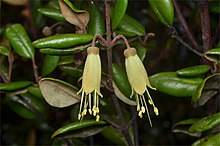Correa lawrenceana var. lawrenceana
Correa lawrenceana var. lawrenceana is the implicit autonym of Correa lawrenceana and is endemic to Tasmania. It is a shrub with papery, oblong leaves and pale green, narrow cylindrical flowers arranged singly on the ends of branchlets.
| Correa lawrenceana var. lawrenceana | |
|---|---|
 | |
| In the Australian National Botanic Gardens | |
| Scientific classification | |
| Kingdom: | Plantae |
| Clade: | Tracheophytes |
| Clade: | Angiosperms |
| Clade: | Eudicots |
| Clade: | Rosids |
| Order: | Sapindales |
| Family: | Rutaceae |
| Genus: | Correa |
| Species: | |
| Variety: | C. l. var. lawrenceana |
| Trinomial name | |
| Correa lawrenceana var. lawrenceana | |
| Synonyms[1] | |
| |
Description
Correa lawrenceana var. lawrenceana is a shrub that typically grows to a height of 4 m (13 ft) and has papery, oblong leaves 20–40 mm (0.79–1.57 in) long, 3–30 mm (0.12–1.18 in) wide and sometimes covered with rust-coloured hairs on the lower surface. Specimens in the north-east of the state have narrow leaves, while those from the south and west have wider leaves with hairy undersides. The flowers are borne singly on the ends of branchlets on a stalk about 5 mm (0.20 in) long. The calyx is shortly cup-shaped, 3 mm (0.12 in) long and 4 mm (0.16 in) wide with rust-coloured hairs on the outside and with a wavy rim. The corolla is narrow cylindrical, 15–20 mm (0.59–0.79 in) long, pale green and covered with soft hairs. Flowering mostly occurs in spring.[2][3][4]
Taxonomy
Correa lawrenceana was first formally described in 1834 by William Jackson Hooker who published the description in his journal, The Journal of Botany.[5][6] In 1855, his son Joseph Dalton Hooker described Correa lawrenceana var. glabra, implicitly creating the autonym C. lawrenceana var. lawrenceana.[7]
Distribution and habitat
This variety of C. lawrenceana grows in forest, mainly in mountainous areas in Tasmania, including on King Island.[2][3] The variety is also listed as occurring in the Australian Capital Territory.[8]
References
- "Correa lawrenceana var. lawrenceana". Australian Plant Census. Retrieved 13 July 2020.
- Wilson, Paul G.; Wilson, Annette J.G. (ed.); Bolton, P.E. (ed.). "Correa lawrenceana var. lawrenceana". Australian Biological Resources Study, Department of Agriculture, Water and the Environment: Canberra. Retrieved 13 July 2020.CS1 maint: extra text: authors list (link)
- Duretto, Marco F. "Flora of Tasmania online - 87 Rutaceae". Tasmanian Museum and Art Gallery. Retrieved 13 July 2020.
- Jordan, Greg. "Correa lawrenceana (Rutaceae)". Key to Tasmanian vascular plants. University of Tasmania. Retrieved 26 June 2011.
- "Correa lawrenceana". APNI. Retrieved 13 July 2020.
- Hooker, William Jackson (1834). "Contributions Towards a Flora of Van Dieman's Land; from collections sent by R. W. Lawrence, and Ronald Gunn, Esqrs., and by Dr. Scott". The Journal of Botany. 1: 254. Retrieved 13 July 2020.
- "Correa lawrenceana var. lawrenceana". APNI. Retrieved 13 July 2020.
- "Census of Plants of the Australian Capital Territory (ACT)". Centre for Australian National Biodiversity Research, Canberra. Retrieved 13 July 2020.